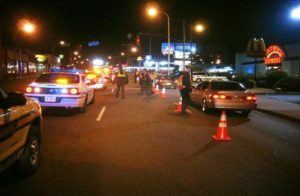Why did the police pull me over for DUI?
Why did the police pull me over for DUI?
Why did the police pull me over for DUI? This page answers that question and relates to the issue of probable cause for a DUI arrest. A related issue is what is considered valid probable cause for a DMV hearing since that is also an issue that must be proven at your DMV hearing in a DUI.
Police officers that handle DUI (Driving Under the Influence) cases are supposed to be trained according to NHTSA standards. NHTSA is the “National Highway Traffic Safety Administration“, and is responsible for safety on the nation’s roads. NHTSA has funded and helped conduct studies to validate various roadside testing, and have come up with the scientifically validated standardized field sobriety tests (the only ones that are validated by scientific studies), and have had law enforcement collect data in thousands of cases to see why people are most likely to be stopped, and what blood alcohol level, if any, that correlates with, over a large sample population. Why did the police pull me over for DUI? Usually, it’s for an NHTSA identified reason that has some articulable connection to DUI.
Orange County Police Training for DUI.
Most of the Police Officers for local agencies, including the CHP, and the Orange County Sheriff’s Department, were trained at the Orange County Sheriff’s Academy, or other academies outside of Orange County, and almost all that handle Orange County DUI were trained through the 30 hour Cavanaugh course, for law enforcement.
Data on Why Police Stop Drivers for DUI.
Why do the police pull someone over for DUI? Well, building upon several previous NHTSA studies, researchers collected data from police officers from across the United States and developed a list of more than 100 driving cues that have been found to predict blood alcohol concentrations (BAC) of 0.08 percent or greater. The list was reduced to 24 cues during 3 field studies involving hundreds of drivers, and more than 12,000 enforcement stops. The driving behaviors identified by the officers are presented in the following four broad categories:
- Problems in maintaining proper lane position
- Speed and braking problems
- Vigilance problems
- Judgment problems
The cues presented in these categories predict that a driver is likely to be DUI at least 35 percent of the time. For example, if a police officer observes a driver weaving across lane lines, the probability of that driver being DUI or above a .08% is more than 50 percent.
However, if that officer observes either of the weaving cues and any other cue of those that are identified, the probability of that driver being DUI jumps to at least .65, or 65 %. Observing any two cues other than weaving indicates a probability of the person being DUI of at least 50 percent.
Some cues, such as swerving, accelerating for no reason, and driving on other than the designated roadway, have single-cue probabilities greater than 70 %. Generally, the probability of DUI increases substantially when a driver exhibits more than one of the cues. More cues mean correlation between the cues and a greater probability that the suspicion of intoxication is correct.
Violations with a High Correlation to DUI
Out of the 24 cues listed above, the one that had the strongest correlation to DUI was driving without headlights on. That is listed in the categories above as “related to vigilance problems”, which includes all of the following, as well as driving without headlights at night:
- Failure to signal a turn or lane change or signaling inconsistently with actions
- Driving in opposing lanes or the wrong way on a one-way street
- Slow response to traffic signals
- Slow or failure to respond to the officer’s signals
- Stopping in the lane for no apparent reason
As a result, if you are stopped for driving without headlights, that seems to be an even greater indicator of you being potentially DUI than weaving, or swerving.
Speeding is Not Correlated with Driving Under the Influence of Alcohol.
Interestingly enough, one of the most common reasons for drivers being stopped, speeding, is not a cue of intoxication. (Speeding is defined as exceeding the posted speed limit or any safe limits for the area and conditions). Since alcohol is a central nervous system depressant, drivers under the influence of alcohol, or driving under the influence of Marijuana (Marijuana DUIs) are more likely to be driving slower, rather than speeding.
The category above known as “speed and braking problems” include the following, none of which are speeding as defined above:
- Driving at a slow speed
- Stopping problems (too far, too short, too jerky)
- Accelerating for no reason after driving at too slow a speed
- Varying speed
What that at least suggests, is that if you were stopped for speeding, that the fact you were speeding alone may not be a reliable indicator that you were driving under the influence.
Contact us today
Contact us. Let us know why you were stopped and any details of your arrest. We will honestly tell you if you might need an attorney or not, and what factors of your DUI in an Orange County case might be important, and why.



